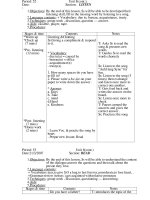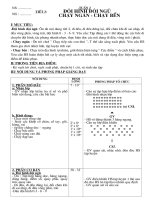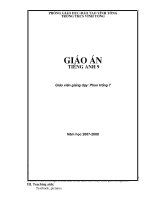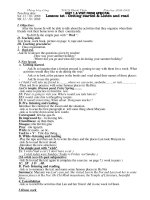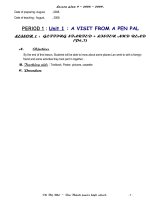Giáo án TA 9- Bài 3
Bạn đang xem bản rút gọn của tài liệu. Xem và tải ngay bản đầy đủ của tài liệu tại đây (112.19 KB, 11 trang )
<span class='text_page_counter'>(1)</span><div class='page_container' data-page=1>
Period: Date of planning :………
Week Date of teaching:……….
<b>UNIT 3: A TRIP TO THE COUNTRYSIDE</b>
<b>Lesson 1: Getting started + Listen and read</b>
<b>I Objectives</b>: By the end of the lesson, students will be able to talk
about life and activities in the countryside .
<b>II Contents: </b>
- New words: home village, lie – lay – lain, the foot of the mountain,
bamboo forest, banyan tree, the shrine, river bank
- Grammar: review the past simple with past wish
<b>III.</b> <b>Teaching methods:</b>
Communicative Approach and others
Techniques: Ask and answer, pair work, group work
<b>IV Teaching aids:</b>
- Students’ and teacher’s books
- Pictures in books
- Tape and cassette player
<b>V Time: 45 minutes</b>
<b>VI Procedures</b>
<b>Ss’ & T’s activities</b> <b>Content</b>
<b>Getting started</b>
- Ss look at the pictures on page 22
and talk about activities in the
countryside.
- Ss answer
<b>Listen and read</b>
<b>Pre reading</b>
- T asks Ss some questions to
introduce the text and new words
- T introduces the text: “ Ba and his
family had a day trip to their home
village ’’
- T turns on the cassette and gets Ss
to listen
1. watering the vegetables
2. swimming
3. taking the eggs
4. harvesting
5. feeding the pigs
6. plowing in the field
7. flying the kite
8. playing soccer
<b>Questions:</b>
- Have you ever been to your home village?
- Where is it?
- How do you get there?
- What do you see on the way to your
village?
<b>New words:</b>
- home village ( n): quê nhà
- lie – lay – laid ( v): n»m
</div>
<span class='text_page_counter'>(2)</span><div class='page_container' data-page=2>
- Some Ss to read the text (maybe)
<b>While reading</b>
- T gives 2 guiding questions and
asks Ss to read the text and answer
- Ss read silently and answer these
questions
- T presents the statements on page
23
- Ss read the text and decide which
is true & which is false
- T asks Ss to answer before the
class
- T corrects if necessary
<b>Post reading</b>
- T asks Ss to read the text again
and answer the questions on page
23
- Some pairs ask & answer before
the class
- T corrects if necessary
<b>Homework:</b>
- Ss learn the lesson and prepare for
next lesson (Listen and speak)
- bamboo forest ( n ): rõng tre
- banyan tree ( n ): cây đa
- the shrine ( n ): miÕu
- river bank ( n ):bê s«ng
<b>Guiding questions:</b>
1. what did Ba, Liz and his family do on
their journey to his home village?
2. What did Liz think of the trip?
<b>Answers:</b>
1. They visited Ba’s uncle, walked up the
mountain to visit the shrine, went boating
in the river & had a picnic on the river
bank.
2. Liz enjoyed the trip very much, she took a
lot of photo.
<b>a) True or false? Check ( </b><b> ) the boxes. Then</b>
<b>correct the false sentences.</b>
1. F Ba and his family had a day trip to their
home village.
2. T
3. F There is a big old banyan tree at the
entrance to the village.
4. F People had a snack under the banyan tree.
5. T
6. F People had a picnic on the river.
7. T
8. F Liz had a lot of photos to show her
parents.
9. T
<b>b)Comprehension questions)</b>
1. It’s 60 km to the north of Ha Noi.
2. Ba and his family got there by bus.
3. The banyan tree is at the entrance to the
village.
4. They saw the shrine of a Vietnamese hero on
the mountain.
5. They had a picnic on the river bank.
6. Liz took a lot of photos to show the trip to her
parents.
7. Liz wishes she could visit Ba’s village again.
Preparing date: ………... Week:
</div>
<span class='text_page_counter'>(3)</span><div class='page_container' data-page=3>
<b>UNIT 3: A TRIP TO THE COUTRYSIDE</b>
<b>Lesson 2: Speak + Listen</b>
<b>I Objectives: By the end of the lesson, students will be able to ask</b>
and give information about their own village
- To listen to specific information and remind the past simple with wish
& use it fluently
<b>II Contents: </b>
- New words: review
- Grammar: review Wh - question
<b>III.</b> <b>Teaching methods:</b>
Communicative Approach and others
Techniques: Ask and answer, pair work, group work, survey
<b>IV Teaching aids:</b>
- Students’ and teacher’s books
- Handouts
<b>V Time: 45 minutes</b>
<b>VI Procedures</b>
<b>* Speaking</b>
<b>Ss’ & T’s activities</b> <b>Content</b>
<b>Pre speaking:</b>
- T asks Ss some questions and
guides how to answer the questions
in part a)
- T asks Ss to asks Ss to ask and
answer again
<b>While speaking:</b>
- T asks Ss one pair to play role:
information B
- One pair ask & answer before the
class
- T asks Ss to write information of
their home village ( if Ss don’t
have a home village, Ss imagine or
make up information similar to
those in box A or B into handouts
- T gets some Ss pairs to play role to
talk about their home village after
Ss practice with their partners.
<b>Post speaking:</b>
- T asks Ss to talk about their home
<b>SPEAK: (p24 )</b>
<b>a) Work with a partner. Read the</b>
<b>questions. Then play the role of A</b>
<b>and B, asks and answer about your</b>
<b>partner’s home village using the</b>
<b>information in the boxes.</b>
1. Where is your home village?
It’s to the south of the city.
2. How far is it from the city?
It’s 30km from the city.
3. How can you get there?
We can get there by bus
4. How does it take to get there?
It takes an hour
5. What do people do for a living in
your village?
They plant rice & vegetables.
6. Does your village have a river?
</div>
<span class='text_page_counter'>(4)</span><div class='page_container' data-page=4>
village through out information
into handouts
- Some Ss talk before the class
- T corrects if necessary
<b>Homework:</b>
- Ss write their home village into
their exercises books
- Ss learn the lesson and practice
speaking
- Ss prepare for next lesson
<b>b) Now ask and answer about your</b>
<b>real home village. If you do have a</b>
<b>home village, make up information</b>
<b>similar to those in box A or B</b>
* Listening
<b>Ss’ & T’s activities</b> <b>Content</b>
<b>Pre listening:</b>
- T guides the require of listening
clearly
- T introduces the situation: “ a trip
of Liz and Ba to the village ’’ and
asks Ss to guess what she is
wearing. Then T introduces new
words
- Ss look at the map & guess where it
is ( where places on the map are)
- T introduces new words
- T writes Ss’ guessing on the board
<b>While listening:</b>
- Ss listen and check their prediction
- Ss listen to the tape and match the
places on the bus route with the
letters on the map
<b>Listen ( p25)</b>
Look at the map. Then listen to the trip to
Ba’s village. Match the places on the bus
route with the letters on the map. Started
at
<b>New words:</b>
- on the bus route: …………
- a pond: ao
</div>
<span class='text_page_counter'>(5)</span><div class='page_container' data-page=5>
- Ss compare with their friends
- Ss listen again and check
- T gives feedback
<b>Post listening:</b>
- T asks Ss to show each other the
bus route they have just listened to
- T has Ss remind the past simple
with wish
- Ss remind and T reviews how to
use and how to form of the present
perfect tense
- T gets Ss to look at the pictures on
page 28 & 29, study the real
situation by answering the
questions. ( using OHP ):
a) What does Ba want?
b) Where is Hoa now? How
does she feel?
c) What is the boy doing?
What does he have in mind?
d) What’s the weather like?
What do they want?
e) What does he think?
f) What do they have in their
mind?
- T gives example
- Ss do exercise 1 on page 28 & 29
- T gives feedback
<b>Homework:</b>
- T asks Ss to review past simple
with wish
- Ss learn the lesson and prepare for
next lesson
- pick sb up: ………
<b>Answer:</b>
A. Banyan tree
B. Airport
C. Highway No 1
D. Dragon brige
E. Gas station
F. Store
G. Pond
H. Bamboo forest
I. Parking
<b>Language focus ( p19 )</b>
<b>The past simple past with wish</b>
1. Usage:
- to express wish that unreal in the
present
2. Form:
S + wish + S +Ved, 2, were + O …
<b>Ex:</b>
- I wish I had a new car.
( I don’t have a new car. )
- I wish I were a bird.
( I am not a bird. )
<b>Answers:</b>
a) Ba wishes he could have a
new bicycle.
b) Hoa wishes she could visit
her parents.
c) I wish I passed the exam.
d) We wish it did not rain.
e) He wishes he could fly.
f) They wish they stayed in
Hue.
</div>
<span class='text_page_counter'>(6)</span><div class='page_container' data-page=6>
<b>UNIT 3: A TRIP TO THE COUNTRYSIDE</b>
<b>Lesson 4: Read</b>
<b>I Objectives: By the end of the lesson, students will be able to</b>
understand the text in details.
<b>II Contents: </b>
- New words: an exchange student, maize = corn, part - time
- Grammar: review
<b>III.</b> <b>Teaching methods:</b>
Communicative Approach and others
Techniques: Ask and answer, pair work, group work, brainstorming
<b>IV Teaching aids:</b>
- Students’ and teacher’s books
<b>V Time: 45 minutes</b>
<b>VI Procedures</b>
<b>Ss’ & T’s activities</b> <b>Content</b>
<b>Pre reading:</b>
- T introduce the text which is about
Van, an exchange student. He is from
Ho Chi Minh City. He is now studying
in the USA. He is living with the
Parker family on a farm outside
Columbus, Ohio.
- T explains “ an exchange student’’
- T gets Ss to tell the class what they
know about life in the country, on the
farm: what do people do? & how do
they relax?
- T reads sentence by sentence and
explains new words
<b>While reading:</b>
- T asks Ss to read the text silently and
answer some questions
<b>READ ( P25 )</b>
<b>New words:</b>
- an exchange student:
……….
- maize = corn: ………..
- part – time: ………
<b>Questions:</b>
- How long will Van stay
there?
He will stay there till the
beginning of October
</div>
<span class='text_page_counter'>(7)</span><div class='page_container' data-page=7>
- T gives feedback & presents the
answers through out the overhead
projector.
- T has Ss read the text and do exercise
a) on page 26
- Ss work in pairs to match the words in
column A with the explanation in
column B
- T gives feedback
- T asks Ss to read the summary, and
then the text
- T guides how to complete by using the
information from the passage to
complete the summary
- Ss work in groups to complete the
summary
- T presents the answers & checks and
corrects
<b>Post reading:</b>
- T asks Ss to talk about the summary
<b>Homework:</b>
- Ss learn the lesson
- Ss prepare for next lesson
do?
Mr Parker is a farmer. Mrs
Parker works part – time at a
grocery store.
- How many children do they
have?
Two children
- What does Van do after
finishing his homework?
He feeds the chicken and
collects their eggs.
- How do the Parker family
spend their weekend?
They eat hamburgers or hot
dogs while they watch Peter
play.
<b>a) Matching:</b>
- maize : corn
- feed : give food to eat
- grocery store: where people
buy food and small things
- part – time: shorter or less
than standard time
- collect: bring things together
<b>b)Complete the summary:</b>
A Vietnamese boy named Van is
living with the Parker family in
the American state of Ohio. Mr
Parker is a farmer and Mrs Parker
<b>works part – time at a grocery</b>
<b>store in a nearby town. They have</b>
two children, Peter and Sam. Van
often does chores after school.
Sometimes, he also helps on the
<b>farm. The family relaxes on</b>
Saturday afternoon and they
<b>watch Peter play baseball. Van</b>
likes the Parkers, and he enjoys
being a member.
</div>
<span class='text_page_counter'>(8)</span><div class='page_container' data-page=8>
<b>UNIT 3: A TRIP TO THE COUNTRYSIDE</b>
<b>Lesson 5: Write</b>
<b>I Objectives: By the end of the lesson, students will be able to write</b>
a short paragraph describing a story happened in the past: a picnic in the
countryside.
<b>II Contents: </b>
- New words: picnic site, blanket, lay out, blind man’s buff, gather.
- Grammar: review the past simple tense.
<b>III.</b> <b>Teaching methods:</b>
Communicative Approach and others
Techniques: Ask and answer, pair work, group work, brainstorming,
discussion, describing
<b>IV Teaching aids:</b>
- Students’ and teacher’s books
- Pictures in books on page 26 & 27
<b>V Time: 45 minutes</b>
<b>VI Procedures</b>
<b>Ss’ & T’s activities</b> <b>Content</b>
<b>Pre writing:</b>
- T asks Ss to look pictures in their
books on page 26 & 27.
- Ss describe picture by picture
about content of these pictures.
- T introduces new words and
guides how to write:
+ Ss read the cues on page 26 & 27
+ Ss talk about what they can see in
each picture
+ Ss look at the pictures and the
information given. Then write a
passage entitled “ A Country Picnic
’’.
+ T models the first sentence
<b>While writing:</b>
- T gets Ss to build the sentences
individually.
WRITE ( p26 )
<b>New words:</b>
- picnic site: địa điểm cắm trại
- blanket: chăn, mền
- lay out: dọn ( thức ăn )
- blind man’s buff
</div>
<span class='text_page_counter'>(9)</span><div class='page_container' data-page=9>
- Ss compare their results with
their friends.
- Ss work in groups to build the
sentences ( each group build the
sentences according one picture )
- When Ss have finished writing, T
takes some writings to present
- Ss look at the results, then T & Ss
check and T corrects if necessary.
<b>Post writing:</b>
- T asks Ss to talk about the picnic
<b>Homework:</b>
- Ss write writing into their
exercise notebooks
- Ss learn the lesson
- Ss prepare for next lesson
<b>Suggested writing:</b>
It was a beautiful day, my friends and I
decided to go on the picnic. We took a
bus to the countryside and then walked
about 20 minutes to the picnic site next
to the river. We put down the blankets
and laid out the food. After meal we
played the games “ What song is it ?’’ &
“ blind man’s buff ’’. late in the
afternoon we went fishing. We enjoyed
our picnic. When we looked the time it
was nearly 6:30 pm. We hurriedly
gathered our things & ran to the bus stop.
We were lucky to catch the last bus & we
arrived home very late in the evening.
</div>
<span class='text_page_counter'>(10)</span><div class='page_container' data-page=10>
<b>UNIT 3: A TRIP TO THE COUNTRYSIDE</b>
<b>Lesson 6: Language focus</b>
<b>I Objectives: By the end of the lesson, students will be able to use</b>
the past simple with wish fluently, preposition of time, and adverb clause
of result.
<b>II Contents: </b>
- New words: review
- Grammar: review the past simple with wish.
Preposition of time
Adverb clause of result
<b>III.</b> <b>Teaching methods:</b>
Communicative Approach and others
Techniques: Ask and answer, pair work, group work
<b>IV Teaching aids:</b>
- Students’ and teacher’s books
- Cues in books on page 30 & 31
<b>V Time: 45 minutes</b>
<b>VI Procedures</b>
<b>Ss’ & T’s activities</b> <b>Content</b>
- T asks Ss to remind wishes
unreal in the present
- T introduces the preposition of
time.
- T introduces the exercise 2 on
page 30
- T asks Ss to look at the itinerary
on page 30 & answer the
questions.
<b>Language focus ( p30 )</b>
<b>Preposition of time:</b>
- in the morning
- in October
- in spring
- in 2006
- in Ho Chi Minh City
- ……
- on Monday
- on the weekend
- on Christmas
- on 10 October
- ……
- at 10 o’clock
- ……
- for
- …
<b>Questions:</b>
</div>
<span class='text_page_counter'>(11)</span><div class='page_container' data-page=11>
- T asks Ss to use the
prepositions in the box to do
exercise 2 on page 30.
- T gets Ss to read the complete
sentence.
- T corrects if necessary.
- T asks Ss to complete the
sentences with on, in, at & for (
exercise 3 on page 30 )
- T gives feedback
- T asks Ss to look at the
sentence: “ Everyone felt tired,
so they sat down under the tree
and had a snack ’’
- T asks the question to elicit the
answer
- T introduces: adverb of result
- T has Ss match the half
sentences
- T gives feedback
- Ss to write all the correct
sentences into their exercise
books
<b>Homework:</b>
- Ss learn the lesson
- Ss do exercises into their
exercise books
- Ss prepare for next lesson
the last day?
2. What time does the meeting at
Raffles Center begin? Finish?
3. What about the meeting at Lion City
Restaurant?
4. What time does the meeting in Raya
Palace begin/finish?
5. What about the meeting at Little
India Restaurant?
<b>E2 p30:</b>
a) at
b) on
c) between
d) till
e) after
f) up to
<b>E3 p30:</b>
a) on
b) at – in
c) in
d) for
e) in
f) at
<b>Question:</b>
What did everyone do when they felt
tired?
<b>Adverb clause of result:</b>
SO: do đó
Usage: to express the result of the
statement before.
</div>
<!--links-->

